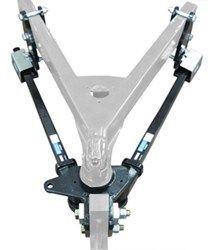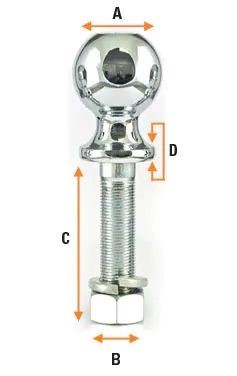Class 1 Receiver Hitches
- 1 1/4" x 1 1/4" receiver tube opening or fixed tongue
- Weight carrying capacity typically up to 2,000 lbs. GTW
Class 2 Receiver Hitches
- 1 1/4" x 1 1/4" receiver tube opening
- Weight carrying capacity typically up to 3,500 lbs. GTW
Class 3 Receiver Hitches
- 2" x 2" receiver tube opening
- Weight carrying capacity typically up to 8,000 lbs. GTW
- May be compatible with a weight distribution hitch
Class 4 Receiver Hitches
- 2" x 2" receiver tube opening
- Weight carrying capacity typically up to 10,000 lbs. GTW
- Usually compatible with a weight distribution hitch
Class 5 Receiver Hitches
- 2" x 2" or 2 1/2" x 2 1/2" receiver tube opening
- Weight carrying capacity up to 16,000, 18,000 or 20,000 lbs. GTW
- Typically compatible with a weight distribution hitch
Weight Distribution Hitches
- Redistributes the tongue weight across the tow vehicle and trailer
- Typically compatible with class 3, 4 and 5 receiver hitches
A weight distribution hitch uses long rods called "spring bars" to leverage the connection point of the combination, transferring some of the tongue weight to the axles of the tow vehicle and trailer. Without a weight distribution hitch, heavy tongue weight can unload the tow vehicle's front tires, leading to reduced steering sensitivity. The most advanced weight distribution hitches also integrate trailer sway control to limit unwanted lateral motion of the trailer.
Sway Control Hitches
Independent Friction Sway Control

An independent friction-style (or bar-style) sway control bolts onto your trailer frame at one end and hooks up to a small hitch ball that mounts to the system head at the other end. By attaching to both the weight distribution system and the trailer frame, the sway-control unit can supply tension to help keep the trailer in line. An interior bar telescopes in and out as your trailer moves. As soon as your trailer begins to move out of line, the friction pads inside the unit make contact with one another and create resistance to help reduce any further side-to-side movement.
Dependent, 2-Point Sway Control

Dependent sway controls are built into weight distribution systems. These systems combat trailer sway as soon as it begins by creating enough resistance to essentially force your trailer to remain in line. Typically, they rely on the downward force of the spring bars to apply frictional resistance to the brackets on both sides of the trailer frame. In order for the trailer to move side to side (sway) it must apply enough force to overcome this resistance and make the brackets slide beneath the spring bars, which would prove very difficult in a normal towing situation.
Hitch Ball (Ball or Trailer Ball)

A Hitch Ball is the ball-shaped attachment that connects the trailer to a hitch. While the diameter of the hitch ball is fairly standard, shank diameters and hitch ball weight ratings may differ. The rating of the hitch ball is just as important as the receiver hitch ratings.
Ball Diameter (A):
Check the top of the trailer coupler for the size of the ball diameter required. The size is usually stamped there. Recreational and light commercial hitch balls come in a variety of sizes including 1 7/8", 2", 2 5/16" and occasionaly 3". In general lighter trailers use smaller hitch balls. It is VERY important to match the trailer to the correct hitch ball.
Shank Diameter (B):
This is the diameter of the threaded shaft that is inserted through the ball mount. Shanks come in a variety of sizes (5/8", 3/4", 1", and 1 1/4") and capacities. (7,000lbs-17,000lbs)
Shank Length (C):
This is length of shaft that extends beyond the mounting base of the hitch ball. It is important to use a shank that is long enough to extend beyond the thickness of the draw bar mounting tab to ensure that enough threads are available to securely fasten the ball to the mount.
Shank Rise (D):
The height of the shank can be used to raise a trailer back to level in the event the "rise" or "drop" of a ball mount is inadequate.

